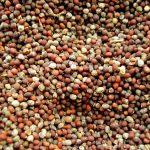
Sowing seeds in October largely depends on your location and local climate. October is generally considered a fall month in the Northern Hemisphere, and in many regions, it marks the transition from the growing season to cooler temperatures. However, in the Southern Hemisphere, October is a spring month, signaling the beginning of the growing season.
Northern Hemisphere: Fall Planting
- Spinach (Spinacia oleracea): Spinach is a cool-season crop that thrives in the fall. It prefers well-drained soil and can tolerate light frosts. Sow spinach seeds directly in the garden or in containers.
- Lettuce (Lactuca sativa): Lettuce is another excellent fall crop. There are various varieties, including leaf lettuce, romaine, and iceberg. Plant lettuce seeds in well-drained soil, and they should be ready for harvest in a few weeks.
- Kale (Brassica oleracea): Kale is a cold-hardy leafy green that becomes sweeter after a light frost. Sow kale seeds in October for a late fall or early winter harvest.
- Radishes (Raphanus sativus): Radishes are fast-growing and can be sown in October for a quick harvest. They prefer cool weather and well-drained soil.
- Garlic (Allium sativum): October is an excellent time to plant garlic for a summer harvest. Separate garlic cloves and plant them individually with the pointed end facing up in well-drained soil.
- Onions (Allium cepa): Similar to garlic, onions can be planted in October for a summer harvest. Plant onion sets or seeds in well-drained soil with plenty of sunlight.
- Chives (Allium schoenoprasum): Chives are a versatile herb that can be grown from seeds or transplants. Plant them in well-drained soil, and they will continue to produce throughout the fall.
- Cilantro (Coriandrum sativum): Cilantro prefers cooler temperatures, making it a suitable herb for fall planting. Sow seeds directly in the garden or in containers.
- Carrots (Daucus carota): Carrots can be grown in the fall, especially in regions where winters are mild. Plant carrot seeds in loose, well-drained soil for best results.
- Parsley (Petroselinum crispum): Parsley is a biennial herb that can be grown as an annual. Plant seeds in October for a fall harvest. It prefers well-drained soil and partial shade.
Southern Hemisphere: Spring Planting
- Tomatoes (Solanum lycopersicum): In the Southern Hemisphere, October marks the beginning of spring, making it an ideal time to start tomato seeds indoors. Transplant seedlings outdoors once the risk of frost has passed.
- Bell Peppers (Capsicum annuum): Similar to tomatoes, bell peppers can be started indoors in October for later transplantation outdoors in spring.
- Zucchini (Cucurbita pepo): Zucchini is a warm-season vegetable that can be started from seeds indoors in October and transplanted outdoors once the weather warms up.
- Cucumbers (Cucumis sativus): Cucumbers thrive in warm weather. Start cucumber seeds indoors in October, and transplant seedlings outdoors when the risk of frost has passed.
- Basil (Ocimum basilicum): Basil is a warm-season herb that can be started from seeds indoors in October. Transplant the seedlings outdoors in spring once the weather is consistently warm.
- Beans (Phaseolus vulgaris): Bush beans and pole beans can be sown directly in the garden in October in the Southern Hemisphere. They prefer well-drained soil and full sunlight.
- Corn (Zea mays): Corn is a warm-season crop that can be sown directly in the garden in October. Ensure the soil is well-drained and has sufficient nutrients.
- Lavender (Lavandula spp.): Lavender is a perennial herb that can be grown from seeds or cuttings. Start lavender seeds indoors in October and transplant outdoors when the weather is consistently warm.
- Dill (Anethum graveolens): Dill is a herb that prefers warmer temperatures. Sow dill seeds directly in the garden or in containers in October for a spring and summer harvest.
- Cantaloupe (Cucumis melo): Cantaloupes, also known as muskmelons, can be started from seeds indoors in October in the Southern Hemisphere. Transplant them outdoors once the weather is warm and frost-free.
In both hemispheres, it’s essential to consider the specific climate and frost dates in your region when planning your seed sowing. Additionally, providing proper care, including adequate watering, fertilization, and pest control, will contribute to the success of your garden. Happy planting!



Leave a Reply